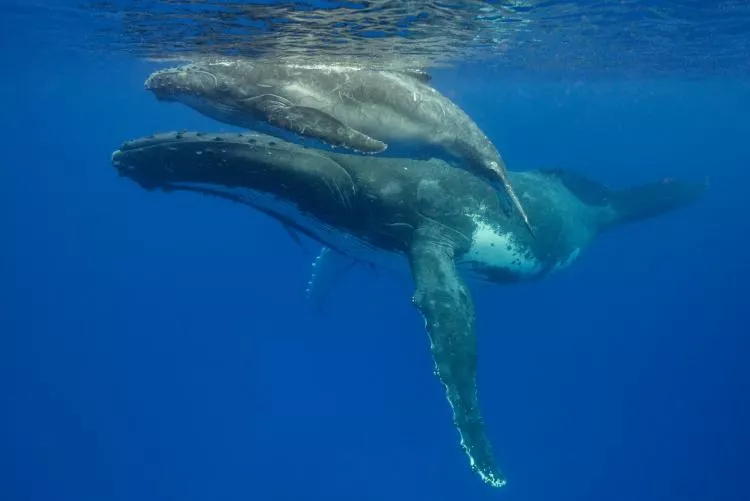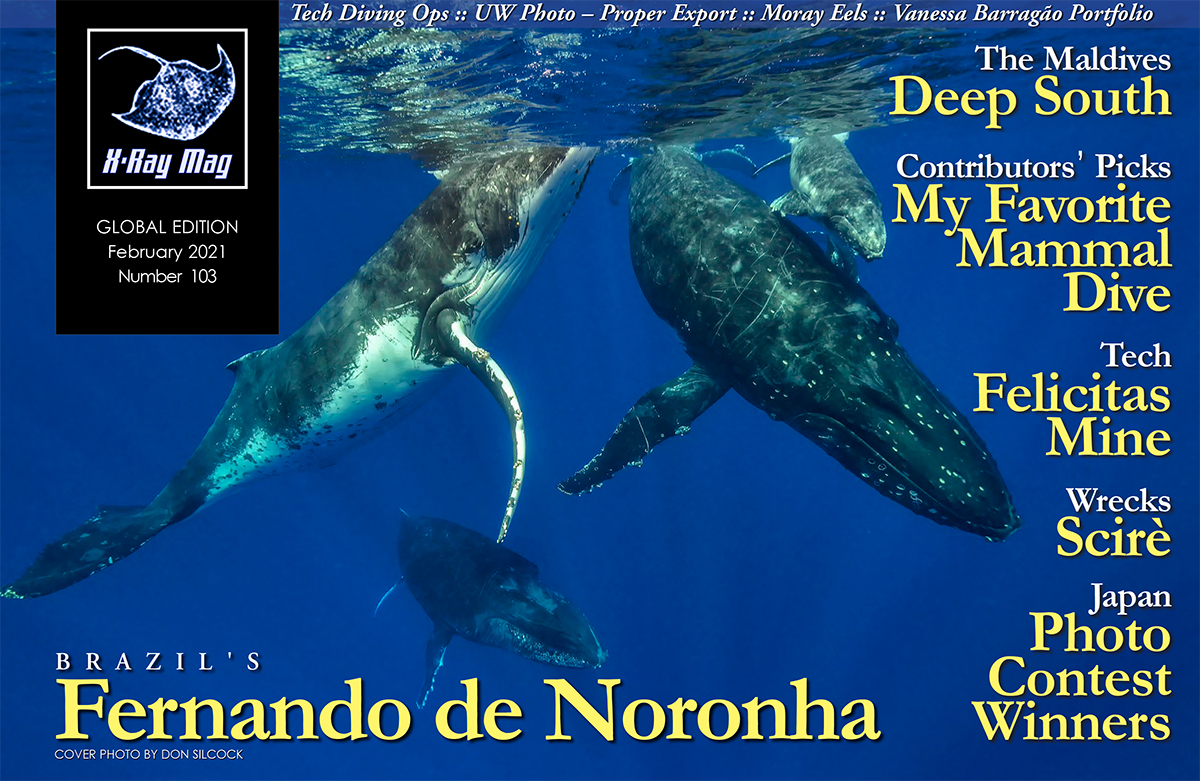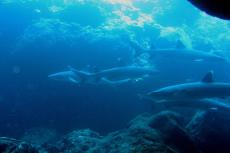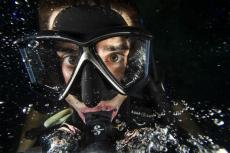We asked our contributors what their favorite marine mammal dive was and they sent us tales and images of magnificent whales, playful seals, endearing sea cows and curious dolphins. X-Ray Mag contributors reveal the intriguing behaviors of marine mammals underwater—from Crystal River in Florida to the tropical waters of Tonga, Dominica, the Bahamas, the Dominican Republic and the Red Sea, to the subtropical waters off Florida, Southern California and Baha in Mexico—where they captured their favorite images.
Contributed by
(To see all photos, please scroll down and download the full article PDF.)
Humpback whales, Tonga
Text and photo by Don Silcock
The South Pacific archipelago that forms the Kingdom of Tonga is one of the best places in the world for in-water encounters with the southern humpback whale (Megaptera novaeangliae). The “Tongan Tribe” is one of the six main humpback populations in the South Pacific. Significantly, it was one of the last groups to be subjected to the horrors of commercial whaling and has also been the slowest of those groups to recover.
The humpbacks start to arrive in Tonga from around the middle of July and call the 169 islands of the archipelago home until mid-October. They come to Tonga for two very basic reasons: to breed and to give birth, having spent the Southern Hemisphere’s summer in the rich waters of the Antarctic, gorging and bulking up on the huge swarms of krill that abound there.
Their annual migration involves a journey of over 6,000km, which takes the whales up the eastern coast of New Zealand into the waters of the South Pacific and is one of the longest known animal migrations in the world!
The islands of the Tongan archipelago offer the warm waters and shelter that the pregnant females need when they give birth. Plus, the deep lagoons are often where the incredible “heat runs” take place as the females select their male suitors.
Apart from the distinctive white coloration on the undersides of the Southern Hemisphere humpback whales, there are no real differences between them and the Northern Hemisphere humpbacks. Technically, though, they are considered a separate subspecies because of their isolation from each other. That is because when it is winter in the Northern Hemisphere, it is summer in the Southern Hemisphere, which means when the northern humpbacks are in their summer feeding grounds around the Arctic Circle, the southern humpbacks are in their winter breeding grounds (like Tonga). So, the two subspecies never actually meet!
Tonga is one of the few countries that allow, under quite strict guidelines, people in the water with the whales—an experience that can (and in my case, did) change one’s life! Big animal encounters, such as those with the Tongan humpbacks, are amazing experiences. What makes Tonga so special though is the “gentle giant” personas of the humpbacks, combined with their intelligence. Because they are mammals and very social creatures, an eyeball-to-eyeball encounter is something that will stay with you for a very long time!
You can read more about the “Tongan Tribe” and the incredible in-water encounters possible with them on my website in the Complete Guide to the Humpback Whales of Tonga.
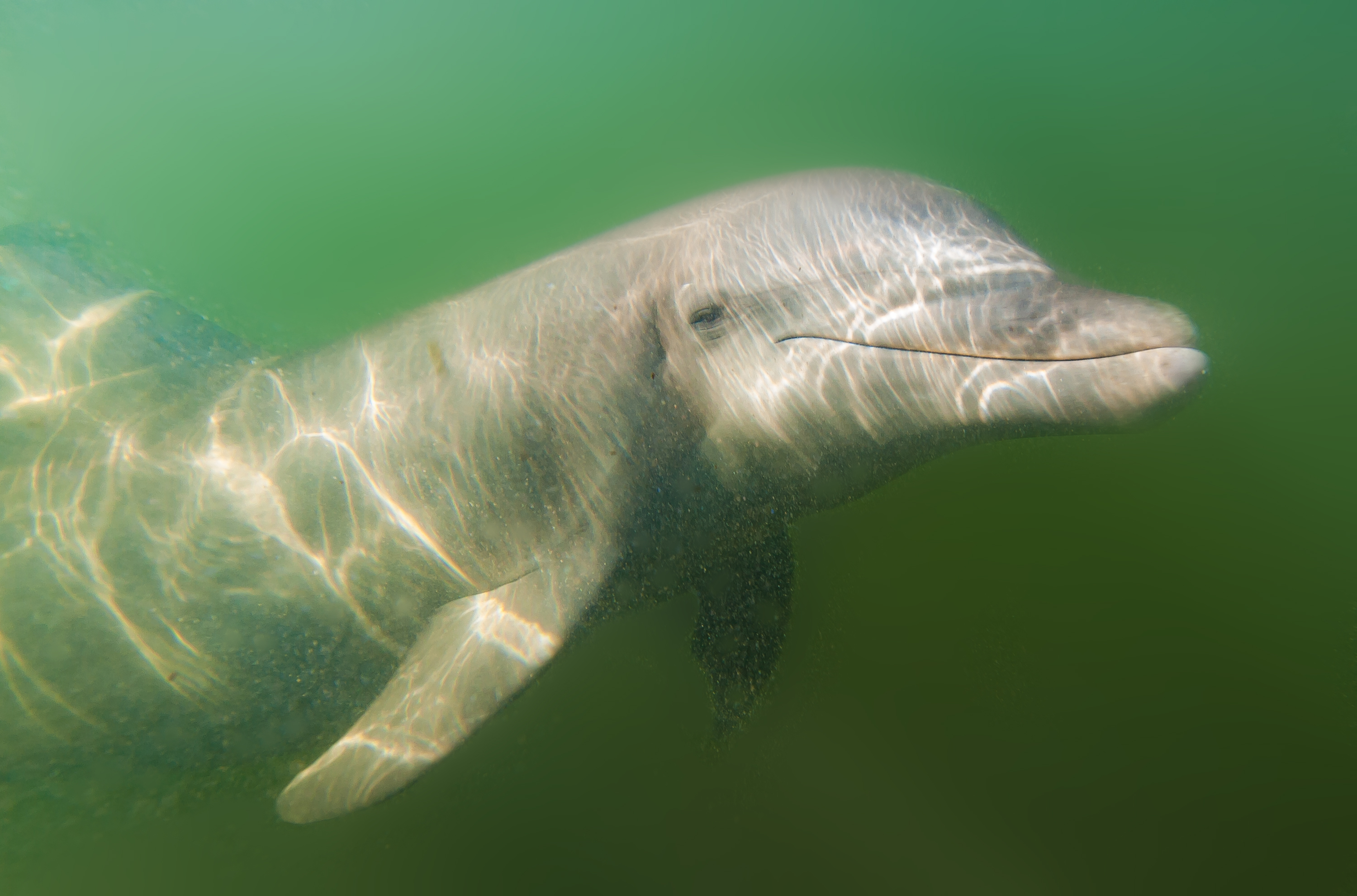
Bottlenose Dolphin, Grassy Key, FL, USA
Text and photos by Larry Cohen
In 2008, I got the opportunity to get in the water with the bottlenose dolphins at the Dolphin Research Center in Grassy Key, Florida. My friend Bette Zirkelbach was a staff member, and she arranged for me to photograph the dolphins. This was my first time in the water with any marine mammal. I found it an exceptional experience.
Dolphin Research Center has a fascinating history. Commercial fisherman Milton Santini collected dolphins for marine mammal parks and aquariums. He created a deep lagoon by his home and started Santini’s Porpoise Training School. A few of the animals starred in the movie Flipper in 1963. In 1972, after Milton’s favorite dolphin passed away, he sold the grounds, and it became the Flipper’s Sea School. In 1984, Jayne Shannon-Rodriguez and Armando “Mandy” Rodriguez acquired the facility. They formed the nonprofit corporation Dolphin Research Center.
The center is now a world leader in marine mammal care, research and education. The Dolphin Research Center used to be the southernmost member of the Marine Mammal Stranding Network. They no longer rescue cetaceans because of the risk of carrying disease back to the resident dolphins. However, they are the licensed manatee rescue team for the Florida Keys.
Their marine mammal population allows for research and data collection. The research focus is on how marine mammals think, their behavior, and husbandry. Many dolphins have been born at the facility. The Dolphin Research Center activities always stay true to the original mission statement:
“To promote peaceful coexistence, cooperation, and communication between marine mammals, humans, and the environment we share through research and education. The health and well-being of Dolphin Research Center’s dolphins holds absolute precedence over all other interests. DRC will undertake no program or activity that compromises this basic commitment.” (dolphins.org)
Even with bad visibility, it was a pleasure being in the water with the dolphins. They were as curious about my camera gear and me as I was about them. I captured the photos with an Olympus DSLR with the Olympus 7-14mm lens and Sea&Sea strobes. Visit: liquidimagesuw.com
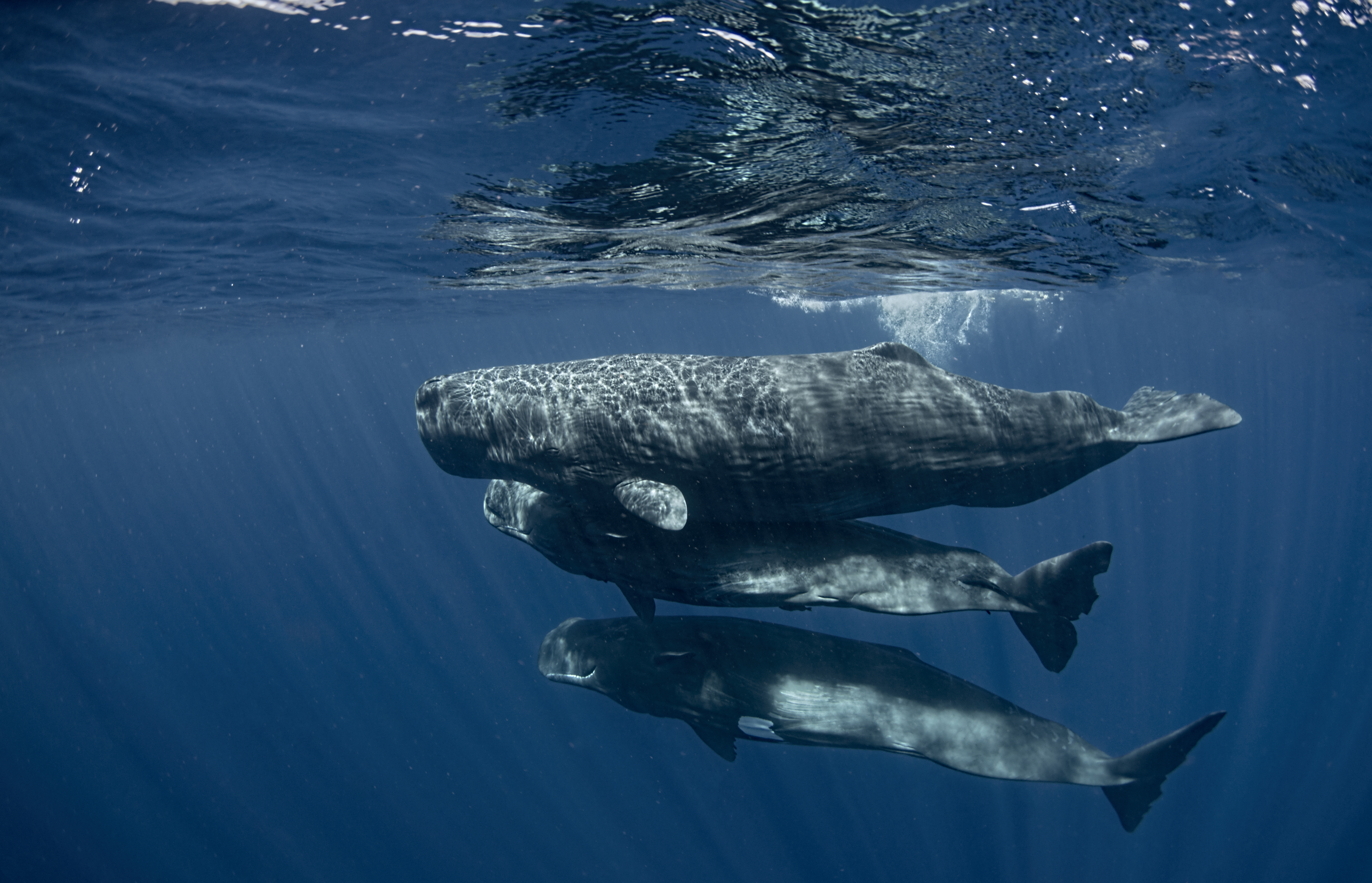
Sperm Whales in Dominica
Text and photos by Amanda Cotton
It is truly a remarkable experience to swim alongside the world’s largest, toothed predator—the sperm whale (Physeter macrocephalus). Having spent almost a decade visiting these majestic whales off the coast of Dominica, I eagerly await my time in the water with them year after year. Their intelligence and curiosity cannot be overemphasized as they are truly in a class by themselves. It is a pure delight when these whales seek out interactions with us divers. Special attention must be given to the boundaries set by, not only the government regulations put in place to protect these whales, but more importantly, the reaction and action of the whales themselves. It is extremely important we respect the rights of these marine mammals during our time on the water as we seek out interactions with them. Marine mammal encounters thrill and excite no matter the species, and oftentimes feels like a gift from the sea. A swim alongside a sperm whale feels like the biggest gift of them all. Visit: acottonphoto.com
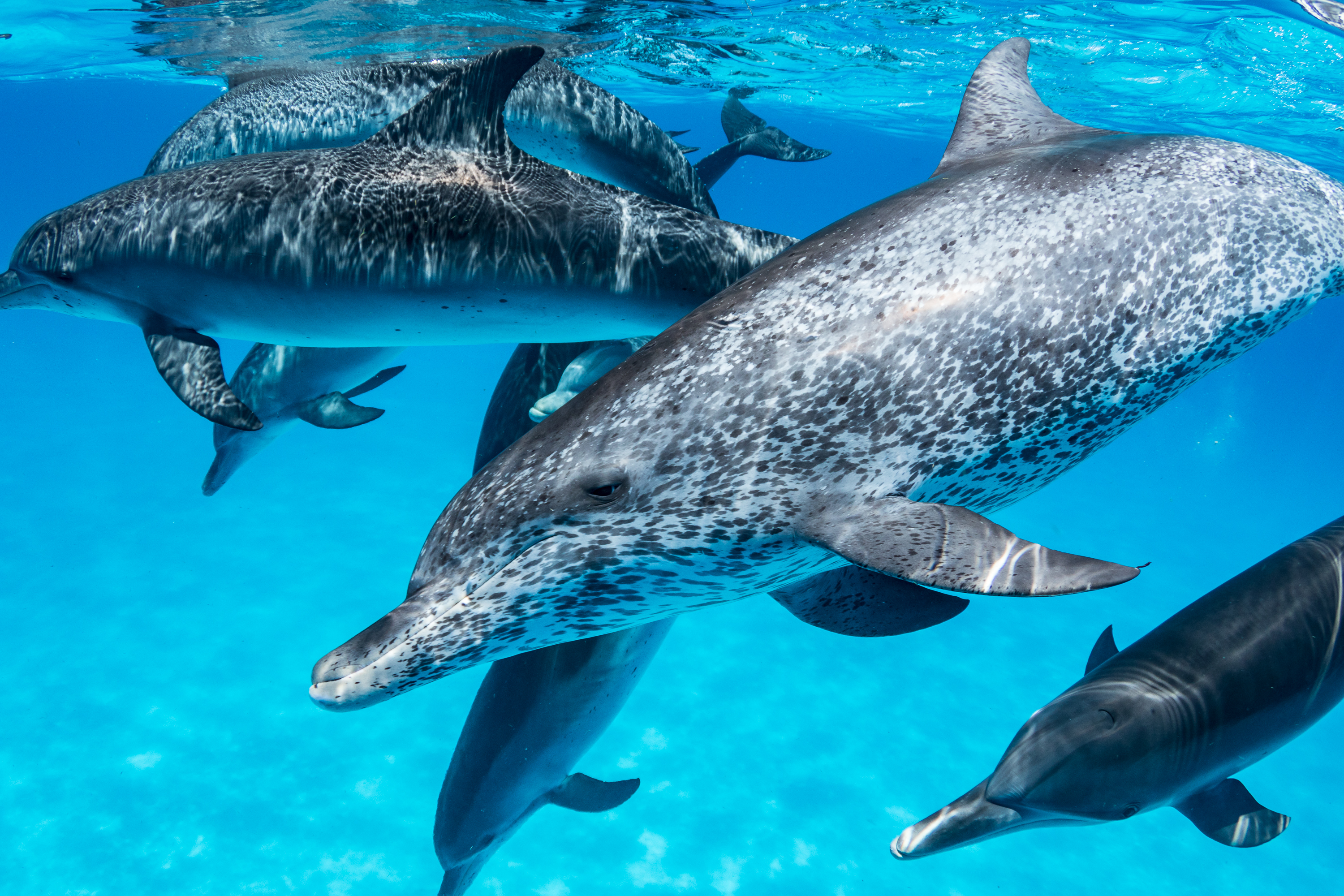
Atlantic Spotted Dolphins in Bimini, Bahamas
Text and photo by Brent Durant
Marine mammal dives are some of my favorites. These encounters have the ability to stir our emotions—to evaporate the fog of day-to-day complacency as we develop a sharp connection with the animal. This is why swimming with Atlantic spotted dolphins (Stenella frontalis) in Bimini, Bahamas is my favorite mammal dive. I have been fortunate to twice visit this little island, spending a total of several hours swimming with these joyous cetaceans. The dolphin dives are snorkel-only since entering the water is a quick endeavor. Spot the dolphins, motor into position, and slip quietly into the water. It is easy to get excited, splashing and swimming in an effort to see the dolphins, but the best encounters come from finding a place of calm, confidence and good water technique. When these elements come together, the dolphins will engage on their own terms, swimming and playing with their new friend—you. One may find that the dolphins mimic your own twists and turns as you engage with them. The experience is truly beyond words. Visit: tutorials.brentdurand.com
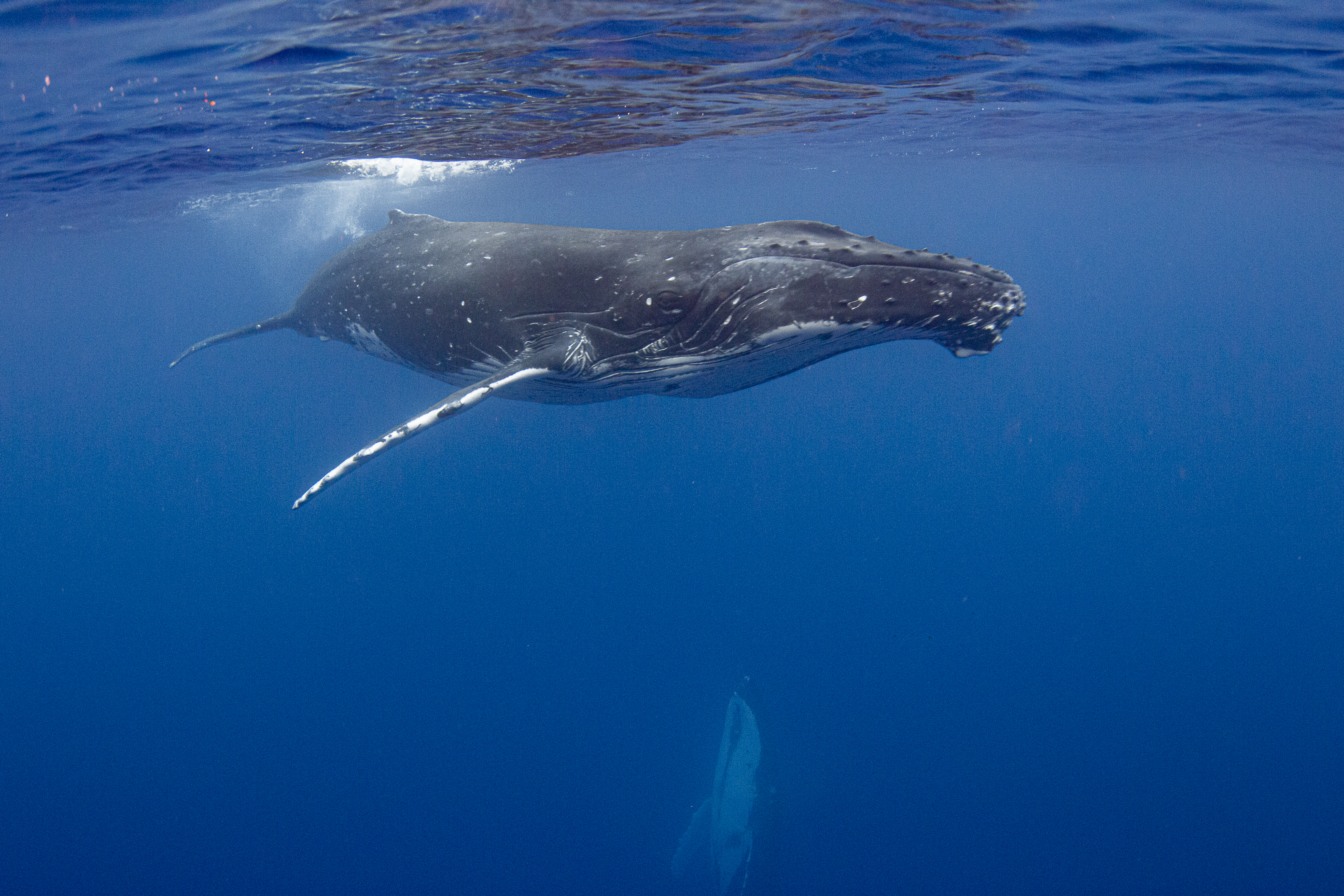
Humpback Whale in French Polynesia
Text and photos by Lureen Ferretti
My favorite marine mammal is the one I have the good fortune of getting close enough to photograph. In 2020, my awe-inspiring and undeniably most incredible experience was with humpback whales (Megaptera novaeangliae) in French Polynesia. Three operators—one in South Tahiti and two in Moorea—used different techniques, but all shared love, passion and respect for the whales.
Most whale watching took place at the surface, waiting for them to come up to breathe or occasionally propel their 39 to 52 feet and 36 to 40 tons of body mass (for an adult) out of the water, resulting in a huge splash. Once the whales got our attention, the operator determined if they were on the move or coming up for air and returning to sleep. If it appeared that they were going to sleep, we would swiftly and quietly enter the water and move in the direction they were observed. Finding them seemed easy, considering their size, but because they were perfectly designed to blend into their surroundings—with black on top, so when looking down, they look like the dark water and ocean floor below, and when looking up at them from below, their white belly resembled the bright sky above—it was not always an easy task. Once spotted, we waited for them to surface again. What an adrenaline rush, being so close to such a massive yet gentle majestic creature! Our group was fortunate; we were able to capture photos and video to relive the experience and share it with friends.
Historically, scientists began tracking humpback whales to gain a better understanding of their migration patterns. They determined that there were 11 different populations of these whales, five from the seas around Antarctica. All humpback whales travel thousands of miles from their Antarctic or Arctic feeding grounds to tropical or sub-tropical areas to mate and calf. The humpback whales found in French Polynesia and Tonga come up from Antarctica, as opposed to those found in Cay Sal Bank, Hawaii, Central America, Mexico and Asia, which travel down from the Arctic. Visit: DeepWaterPics.com. SOURCES: Brittanica, NOAA, Rove.me
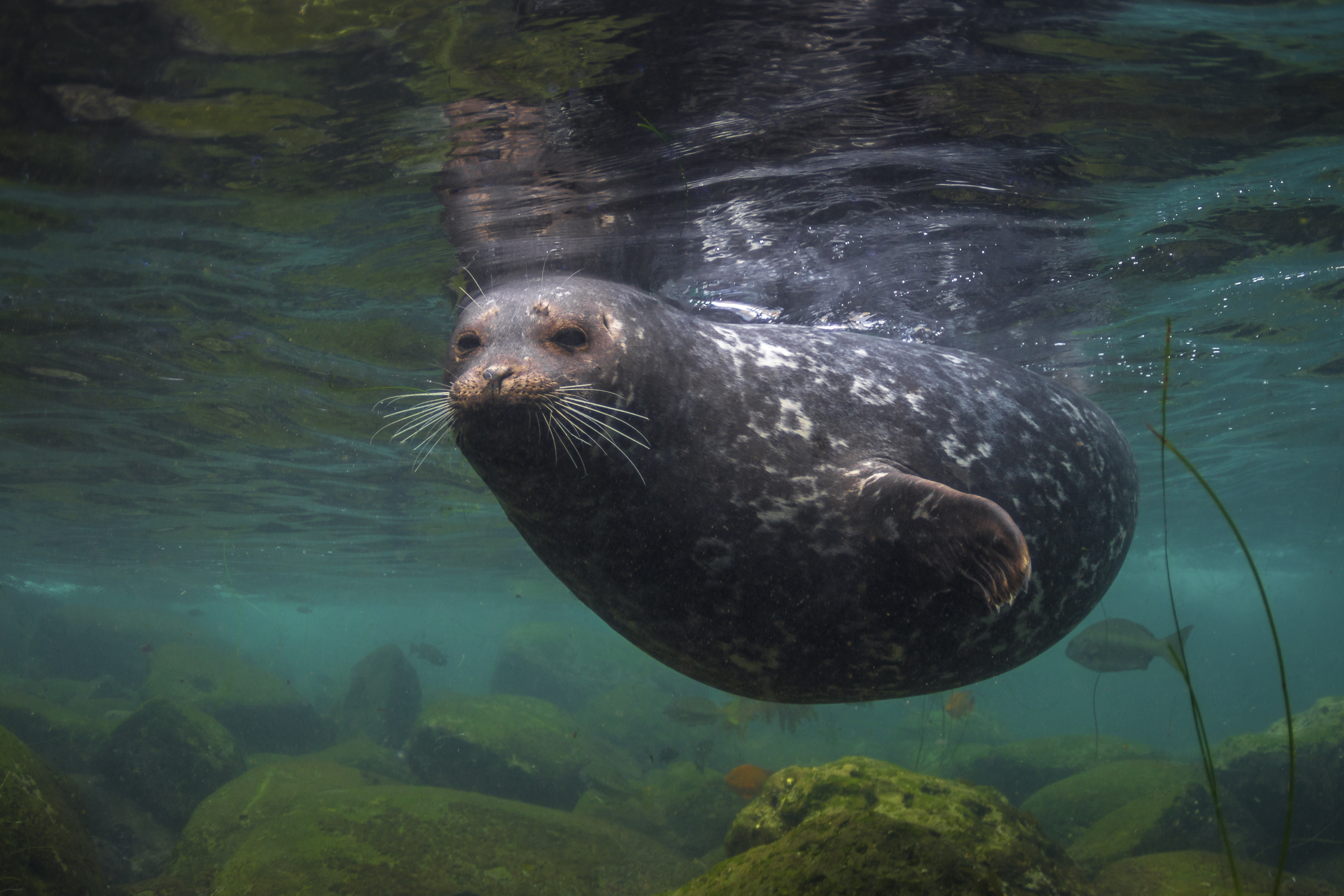
Harbor Seal at La Jolla Cove in California, USA
Text and photos by Frankie Grant
La Jolla Cove is well-known as one of the best shore dives in Southern California. Here at “The Cove,” divers can explore meandering kelp forests, sea caverns, surf grass beds and deep underwater canyons, depending on which path you would like to take! It is also notably known for its pinniped interactions, including California sea lions as well as today’s guest, the harbor seal. Normally, these creatures are quite shy and often avoid encounters with divers, leading to only fleeting, over-the-shoulder glances from these beautiful creatures. On this particular day, upon completion of a 90-minute shore dive through the kelp forest, I returned, feeling rather unenthusiastic about the images I had captured—that is, until I found this curious female harbor seal in the shallows, waiting for me near the beach. I remained motionless as she came in for several minutes and examined both me and her reflection in the dome port. After four to five minutes, she turned and left, then came back for one last pass before heading back out into deeper water. Visit: frankiegrant.com
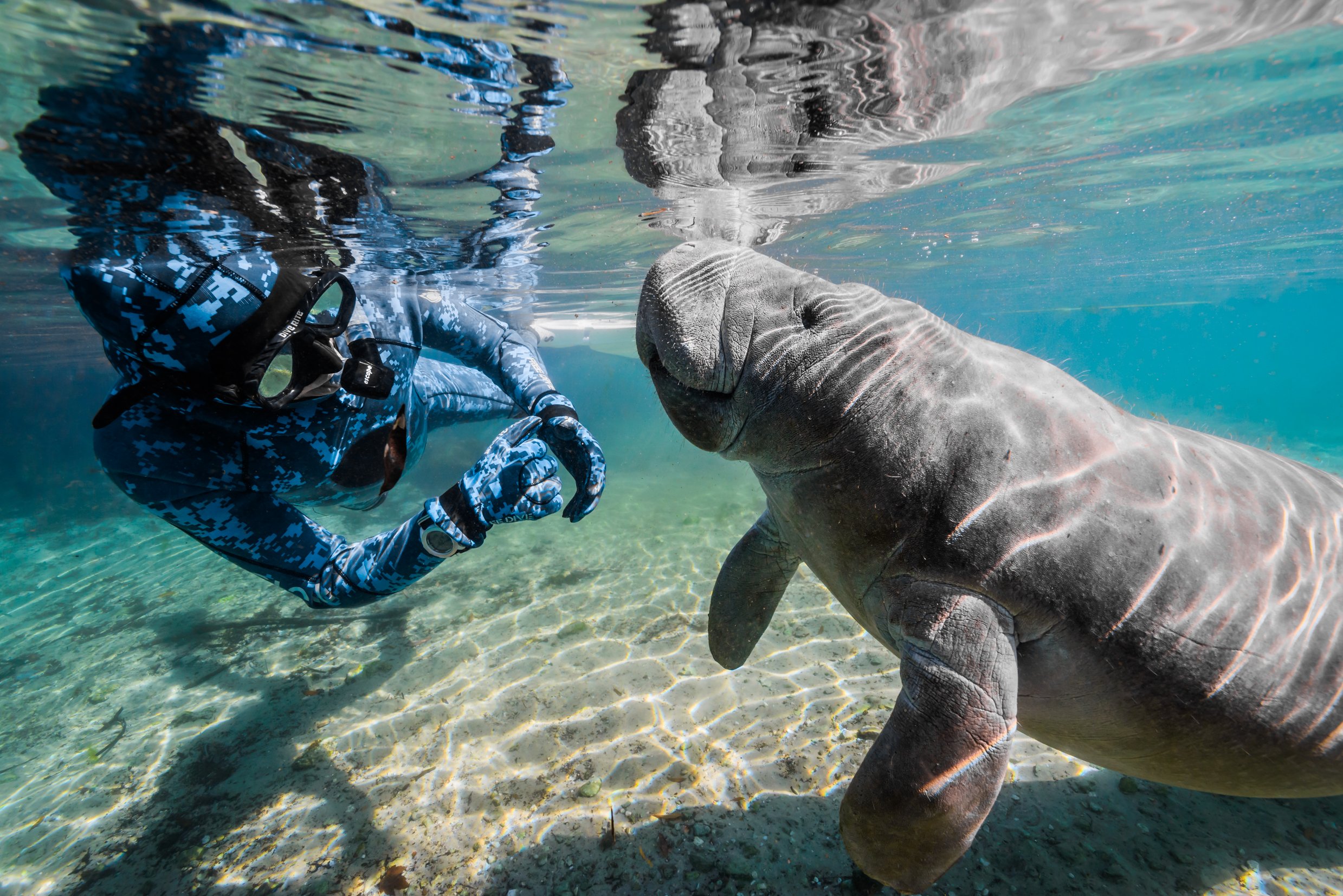
Manatees, Florida, USA
Text and photos by Jennifer Idol
American manatees are as synonymous to Florida as orange juice and palm trees. They migrate from surrounding oceanic waters to warmer springs in winter to raise their young. They can be found in springs such as Homosassa Springs and around Crystal River in Three Sisters Springs on the western side of the state. On the eastern coast, they are found in areas like Blue Heron Bridge and Blue Spring in the St. Johns River.
I grew up in Texas and Florida, so these beautiful sea cows have been a part of my memories since childhood. Clear springs enable viewing manatees from above water too, though snorkeling encounters are the best way to see them.
They were reclassified from an endangered species to a threatened species in 2017 and are also protected under the Marine Mammal Protection Act. To control interactions, paid permits are required of professional photographers and filmmakers to photograph manatees in Crystal River National Wildlife Refuge. Strobes are not permitted.
Also known as the West Indian manatee, these mammals are gentle, slow-moving vegetarians that are decreasing in number due to boating injuries and loss of habitat. All species of manatees, including dugongs, are listed as vulnerable. Please visit: uwDesigner.com
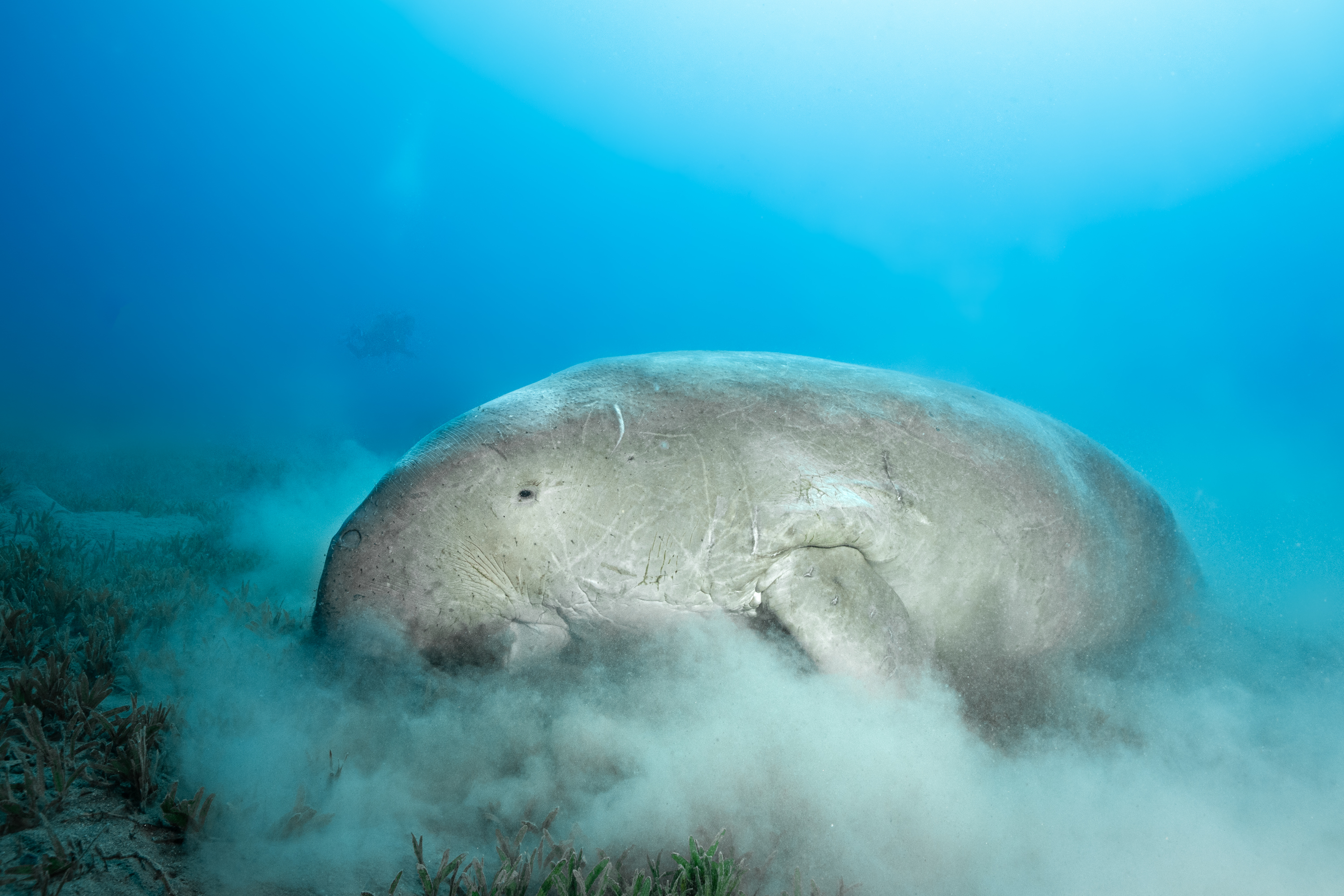
Dugong in Marsa Alam, Egypt
Text and photos by Kate Jonker
Twenty years ago, whilst on my Open Water Diver course, I came across an article on manatees and how they would hug you and never let you go. Although intrigued, I was a little scared at the possibility of “drowning by manatee” but knew I simply had to see one.
Living in South Africa, it was unlikely I would ever get to see a manatee, but the chance of seeing its “cousin,” the dugong, was far greater—especially in the Red Sea. After unsuccessfully searching the Red Sea for 15 years, I heard about a resident dugong in Marsa Alam—and I packed my bags!
Within 90 minutes of arriving in Marsa Alam, I was climbing onto a small zodiac to search for the dugong when the skipper shouted, “It’s here!” He had seen the tell-tale sign of snorkelers frantically swimming on the surface in pursuit of a dugong. I could not contain my excitement and hoped they would not chase it away.
Just as we reached the group of snorkelers, a huge white shape emerged to greet us—a dugong! We waited for it to start grazing on the sea grass below and slowly descended to meet it. The docile giant ignored us as it hoovered up the sea grass, occasionally ascending for air and returning to join us again. I was amazed at how much it ate and how at ease it was with us. I was also relieved not to have been hugged to death so that I could live to tell the tale of finally meeting this elusive creature! Visit: katejonker.com
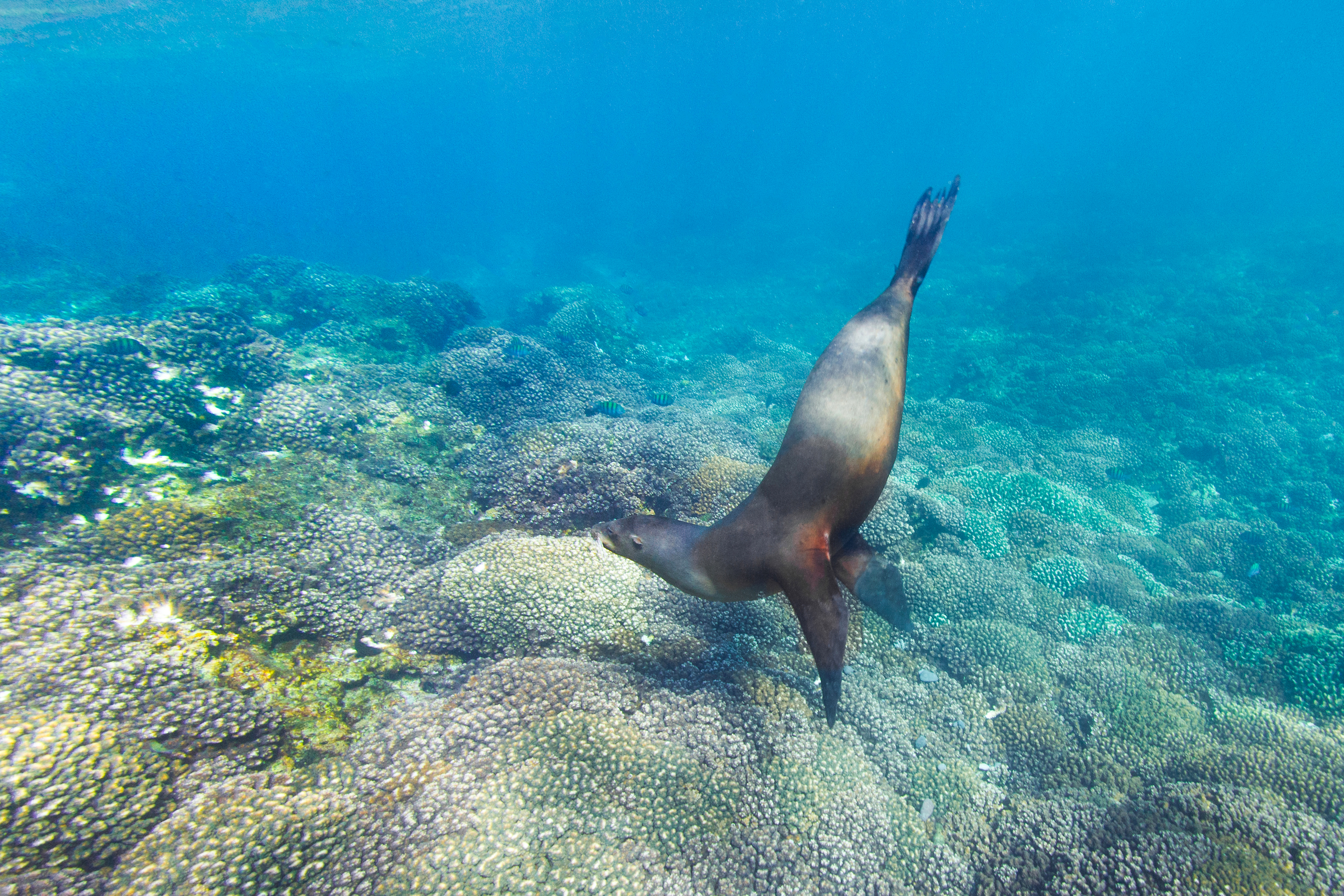
Sea Lions at Land’s End, Cabo San Lucas, Baja California Sur, Mexico
Text by Kelly LaClaire. Photos by Kate Holt
My two dive companions and I back-rolled into the shallow water near the rocks at Land’s End, Cabo San Lucas, and sank towards the soft, sandy bottom at four meters. Before we could even get oriented, we were swarmed by a group of adolescent sea lions chasing each other through our bubbles. They were lithe, energetic creatures and their game of cat-and-mouse did not stop because we had intruded. A few paused to take a curious glance at us, but just as quickly, they continued twisting in sinuous figure eights before darting off again, mouths open in pursuit of their playmates.
“My goodness,” I thought to myself. “They’re like puppies.” I glanced at my dive buddies. They were both smiling, and I smiled back. It was impossible not to; these animals were delightful. And watching them—being near them as they play—was absolutely mesmerizing. I wanted to stay right there for the rest of the dive. One of the bigger bulls of the colony had other ideas, however. He got a little grumpy that we were so close to his rock and rushed me, veering off at the last second. He was telling me I was in his territory and I took the hint. We moved off reluctantly, following the sand to deeper waters, flashing the Hawaiian shaka sign, i.e. “Right on, that was awesome!”
A few minutes later we were at 20m when a small, sunken fishing boat appeared. It was covered in small corals and teeming with life. Three giant porcupinefish caught my eye. They were nearly a meter long and I blinked twice. I had never seen pufferfish even approaching that size. I began to wonder what they had been feeding on when a flash of brown shifted my gaze. The sea lions had followed us. Two of them had caught up to a smaller third and momentarily pinned him down on the sand a few meters away. Twisting and snapping, the little one coiled his body in a tight circle and squirmed free before shooting past us—the chase was back on.
Again, I was struck by their resemblance to canines. It was like watching a pack of friendly, underwater dogs that all got the zoomies at the exact same time. It was sheer underwater pandemonium. I could dive this spot every day and I doubt it would ever get old. A few watchful cows cruised by, keeping an eye on the pups and occasionally joining the game when the mood took them—or when one of the pups cajoled them into it. As usual, my air got low before anyone else’s and my dive had to end far earlier than I would have liked. I signaled my buddies, who were always understanding, and we drifted up slowly, watching the chase continue below us. We reached the surface, and my dive buddies were all smiles. “That was the best, EVER!” said one. “Hell yeah,” replied the other. “Let’s do it again!”
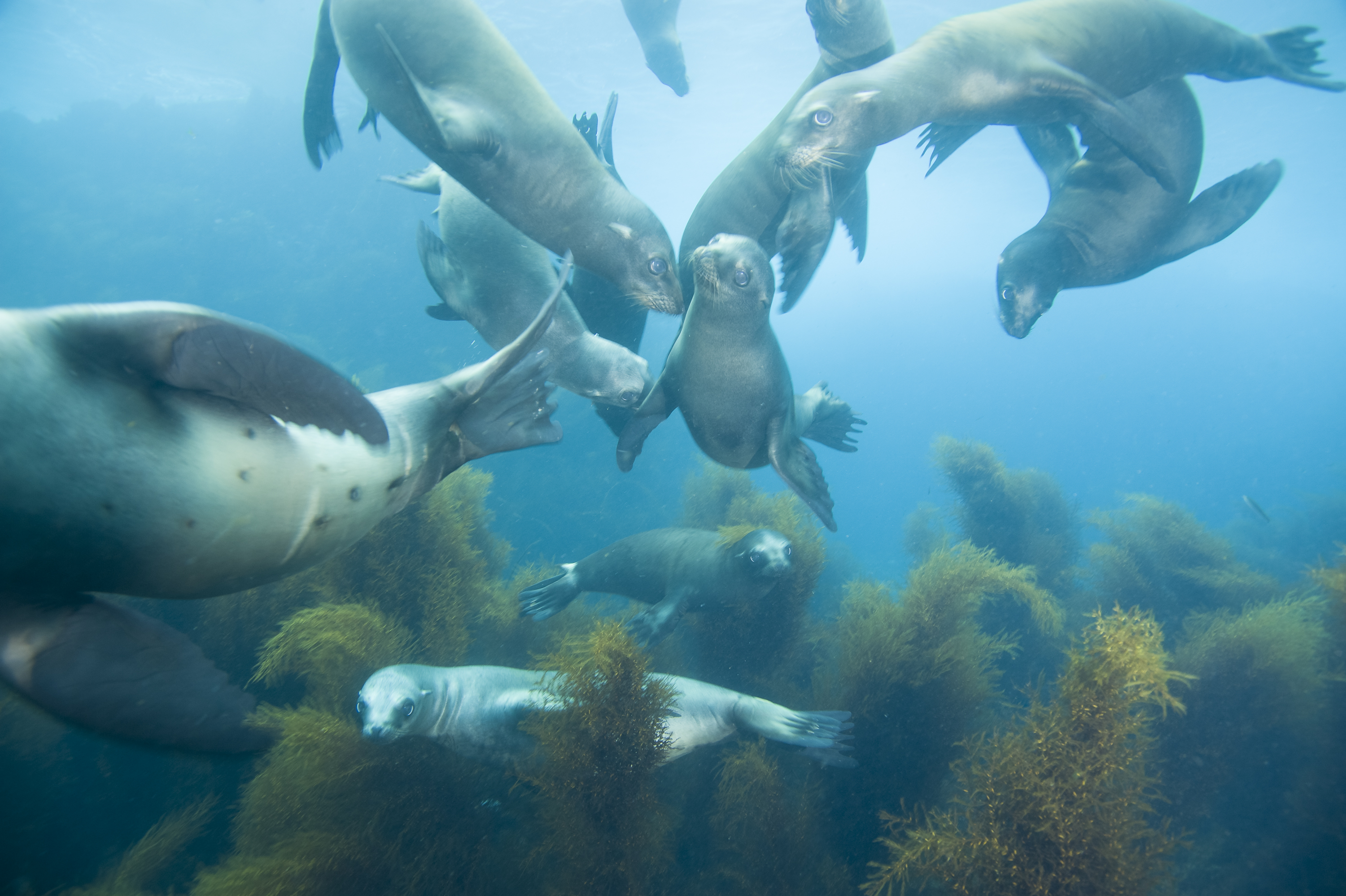
California Sea Lions at Coronado Islands, Mexico
Text and photos by Matthew Meier
The Coronado Islands are located eight miles west of Baja California, Mexico, just 15 miles south of San Diego, California, in the Eastern Pacific Ocean. One of my favorite places to dive with California sea lions is off of North Island, at a dive site called Lobster Shack. These curious and playful creatures are especially active in the fall when the adolescent pups have grown strong enough to venture away from their parents. I tend to stay in the shallow waters, close to the rocky shoreline, to take advantage of the daylight overhead and the numerous sea lion teenagers plunging off the rocks to investigate the divers below. It is often possible to have 15 to 20 sea lions playing in front of you, blowing bubbles, gazing at their reflections in a mask or dome port and occasionally nibbling at your fins. In lesser numbers, you can also encounter harbor seals and the random elephant seal at the islands. When a big male or bull sea lion swims past, he is marking the boundary of the rookery, or breeding colony, and if he starts barking at you underwater, it is advisable to back up. Additional marine mammals such as Pacific bottlenose and common dolphins, as well as gray, humpback, fin and blue whales, can be seen during the transit to and from San Diego. Visit: MatthewMeierPhoto.com

Humpback Whales in the Dominican Republic
Text and photos by Brandi Mueller
Between the months of January and March, the North Atlantic humpback whale population migrates to warmer waters and many of them spend the winter at the Silver Bank, a shallow area about 90 miles off the Dominican Republic. Each year, pregnant females give birth here and mating occurs. The shallow waters protect the babies from predators like sharks, and the mothers nurse their young and get them ready to migrate to the northern waters to feed in the summer months. A few permits are given for snorkelers to visit the area to have passive interactions with the whales. It is hard to explain how incredible it is to be in the water with such massive and beautiful creatures (they can be as large as 40 to 50ft), particularly when they make eye contact, and you are reminded that they are mammals just like we are.
The mothers and babies were particularly amazing to see. Mothers only breathe about once every 20 minutes, but the babies have to come to the surface to breathe more often. They often look like they are snuggling under mom’s chin until it is time to go to the surface and they take a breath and return back to mom. It was also incredible to see the mothers teaching behaviors like breaching where the mother would jump out of the water and then, a few seconds later, the baby would do the same.
There are 14 known humpback populations, and the whales almost never cross into populations in other parts of the world. The Northern populations tend to have fewer white patches than the Southern populations, like those often seen by snorkelers in Tonga. Each population will have a seasonal song that changes slightly over time, but it is sung by the entire group. Different populations will have different songs. Each humpback can be identified individually by its unique tail pattern. Visit: brandiunderwater.com
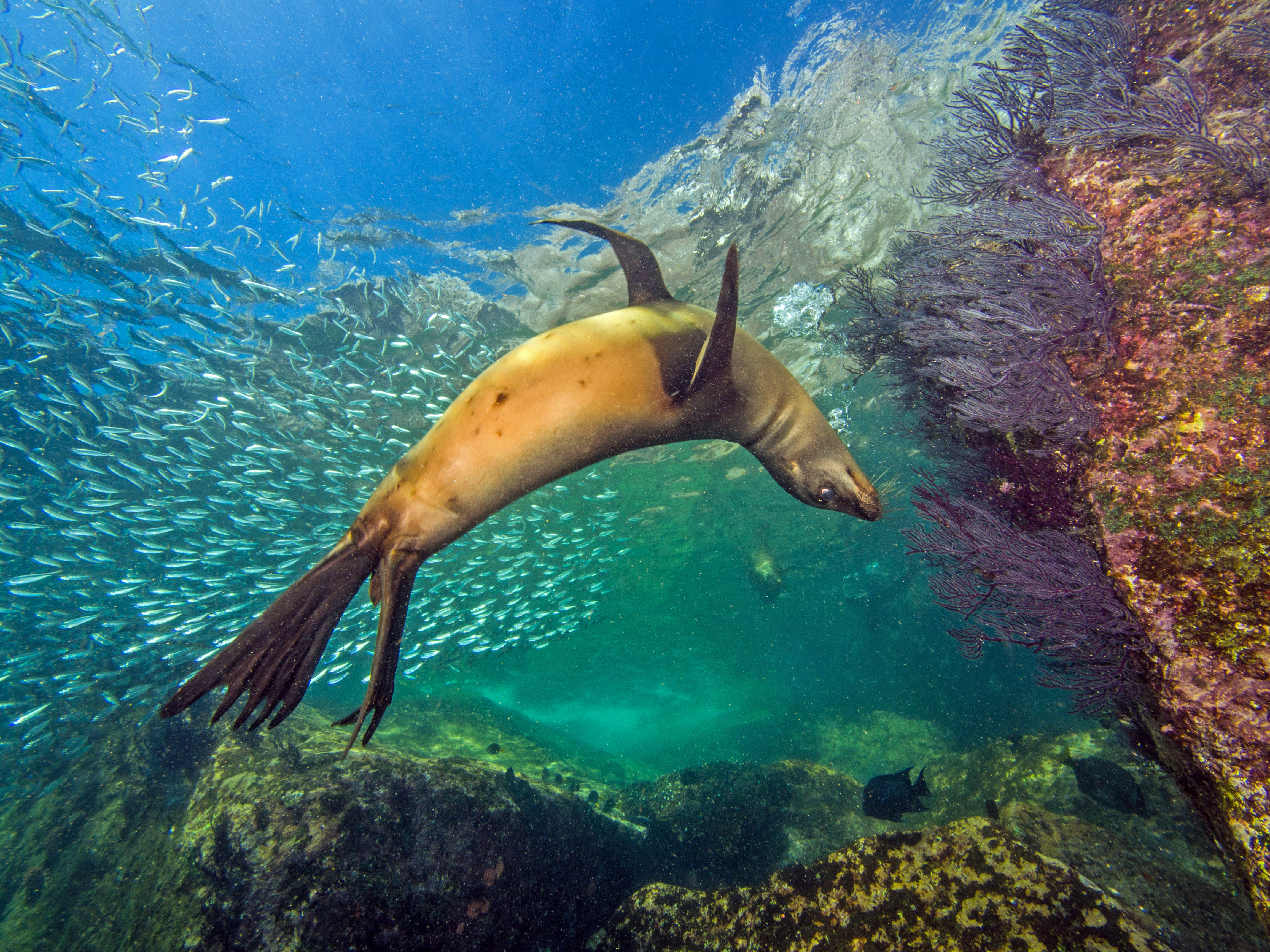
California Sea Lions at La Paz, Mexico
Text and photos by Olga Torrey
Isla Espíritu Santo is a two-hour boat ride from La Paz. This island is protected and part of the Biosphere Reserve by UNESCO. A colony of California sea lions inhabits the northern end of the island. When I was there, I saw a group of 15 individuals. Among them was a large male with females and a few pups. Females choose their mates while moving through different territories.1
The females avoided males that were too aggressive or energetic. This behavior explained why the large males spent their days lazily floating on their backs, sunning their bellies under the bright sun and not worrying about the pups. Unlike the females and puppies, the bulls did not come very close to the divers and snorkelers. The females chased their pups, trying to prevent them from being too playful. Gulf of California sea lions stay in the Gulf year-round. They do not migrate.1 The plankton-enriched waters teemed with life. Large schools of sardines were so dense that as they passed, it felt like a vast cloud had come over my head, blocking out the sun.
It was my first time diving face-to-face with the California sea lions. Pups chased the schools of sardines and then turned their attention to my camera strobes and fins, playfully biting them, to my delight. I gave my blue rubber shoe to one pup to play with, and the sea lion was so happy with its new toy! It was so fun that I wished I could have another day to dive with the sea lions. La Paz is at the top of my list of favorite dive sites because of the rich marine life, fine weather, good food and friendly people there. I will gladly make my way back to visit Mexico the next time the opportunity presents itself. All images were captured with an Olympus OM-D E-M5 camera in a Nauticam housing. I used the Panasonic Lumix G Vario 7-14mm f/4 ASPH lens. For lighting, I used dual Sea&Sea strobes. Visit: fitimage.nyc. 1 SOURCE: Wikipedia.org
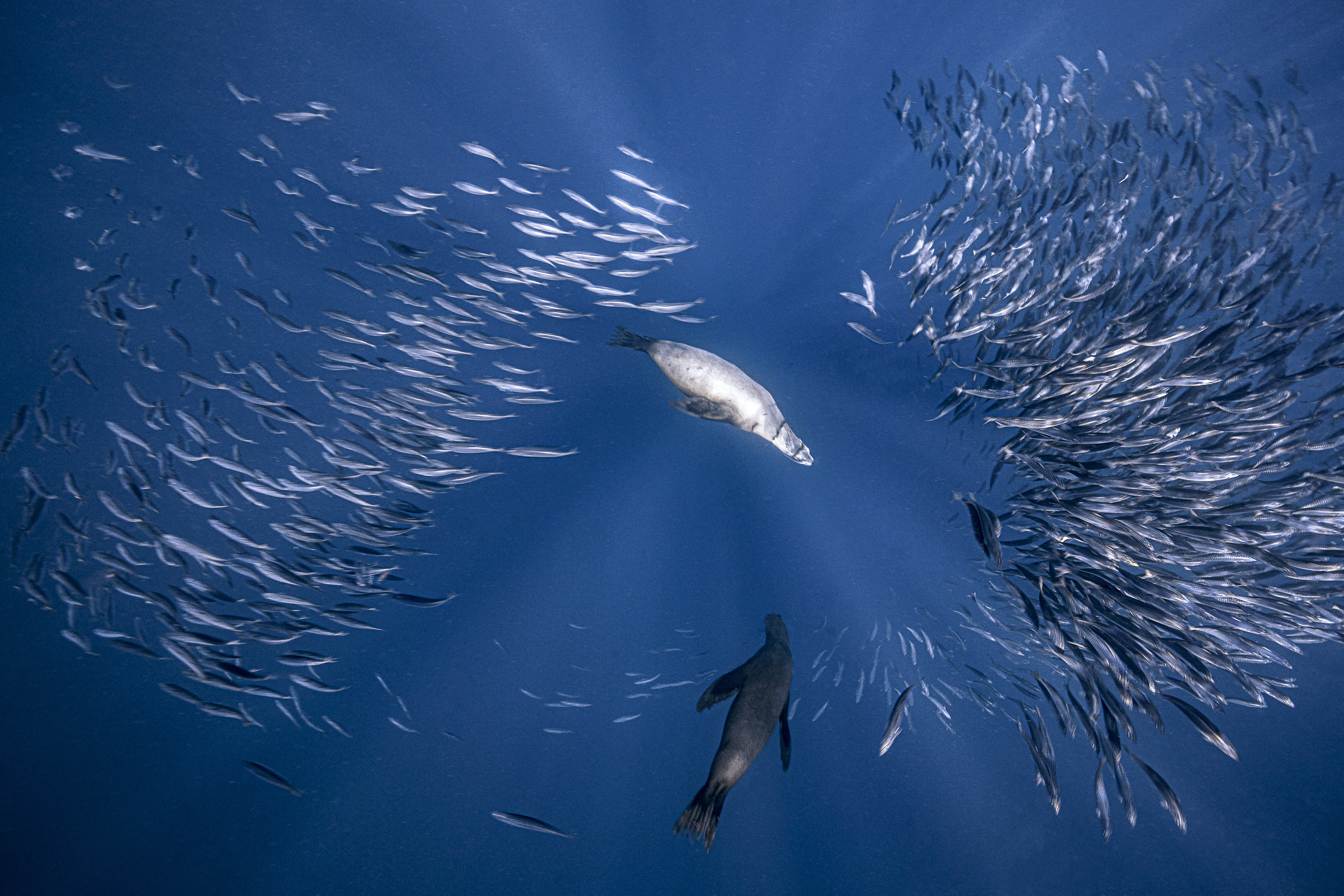
Sea Lions and Bait Ball at Magdalena Bay, Mexico
Text and photos by Beth Watson
My favorite mammal encounter is with sea lions during the migration of bait fish in Magdalena Bay, Mexico. This wildlife hot spot is located along the Pacific coast of the Baja California Peninsula. It is an extraordinary habitat made up of mangroves, barrier beaches and sand dunes, which help support the rich marine ecosystem. Bait fish migrate through the area, congregating in massive numbers, generating lots of oceanic activity. The fish attract an abundance of predators, including sea lions, whales, dolphins, mobula rays, sharks, birds and other mammal and marine species. A typical day is spent on the open ocean searching for frigates and other bird species. Birds diving into the ocean are an indication that a bait ball may be near the surface. Once a bait ball is found, it is time for the snorkeler to calmly and quietly slip into the water. It is exciting—you never know what will show up! It is an unforgettable experience to be in the water while this predation is taking place. Visit: bethwatsonimages.com

